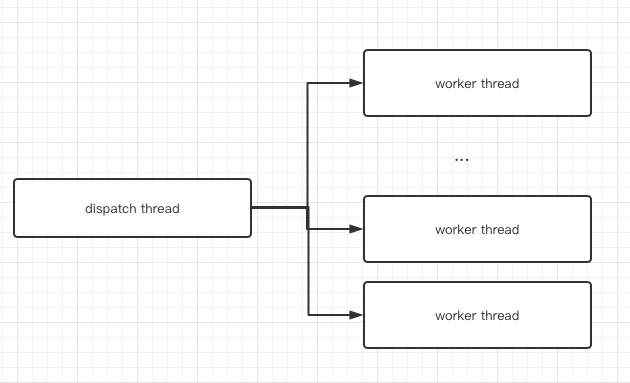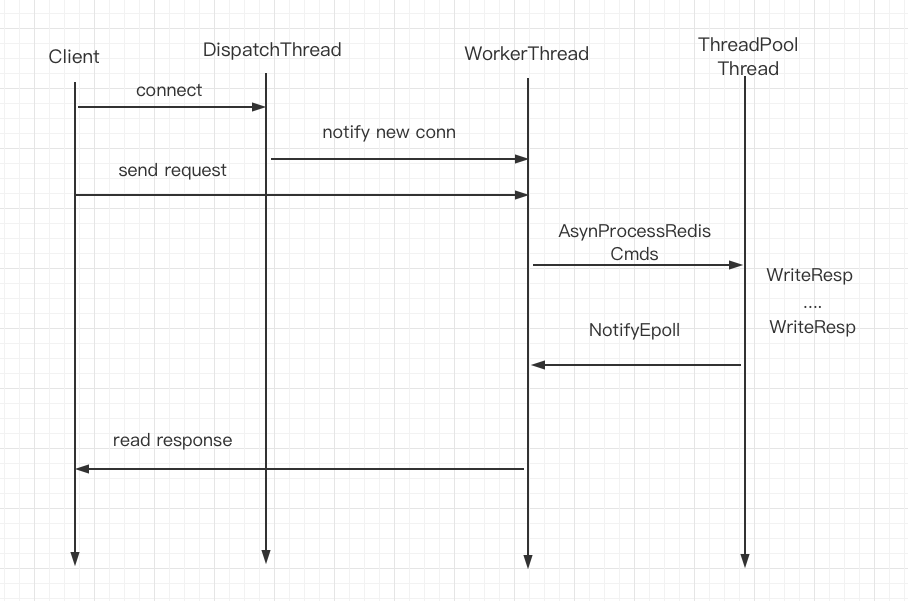Pika 线程模型简介

Introduction
Pika是Qihoo360 开源的一款兼容redis协议的高性能kv存储服务,其与redis最大的不用点是其数据是基于磁盘而不是基于内存。同时使用了多线程的方式提高了读写效率。更多的整体设计和实践细节参见Wiki的设计实现板块。这里是更多做代码层面分析,适合想要从事Pika开发的同学。
Pika使用了同样是Qihoo360 开源的Pink 网络库,如果要了解pika的代��码,首先要了解其网络库的网络模型,和调用关系,下面我们来看一下Pink的网络模型。
线程模型
一切从Thread 开始
class Thread {
int Thread::StartThread() {
return pthread_create(&thread_id_, nullptr, RunThread, (void *)this);
}
void* Thread::RunThread(void *arg) {
// thread 的执行函数
thread->ThreadMain()
}
virtual void *ThreadMain() = 0;
}
Tread 类只是对pthread 调用进行了一层封装,值得注意的是ThreadMain 是各线程的入口函数。
ServerThread
class ServerThread : public Thread {
const ServerHandle *handle_;
void ServerThread::DoCronTask();
void ServerThread::ProcessNotifyEvents(const PinkFiredEvent* pfe);
virtual void HandleConnEvent(PinkFiredEvent *pfe) = 0;
virtual void HandleNewConn(int connfd, const std::string& ip_port) = 0;
void *ServerThread::ThreadMain() {
while (!should_stop()) {
DoCronTask();
// epoll_wait
nfds = pink_epoll_->PinkPoll(timeout);
for (int i = 0; i < nfds; i++) {
if (pfe->fd == pink_epoll_->notify_receive_fd()) {
ProcessNotifyEvents(pfe);
continue;
}
if (/*is listening fd*/) {
connfd = accept(fd, (struct sockaddr *) &cliaddr, &clilen);
handle_->AccessHandle(ip_port);
/*
* Handle new connection,
* implemented in derived class
*/
HandleNewConn(connfd, ip_port);
} else {
/*
* Handle connection's event
* implemented in derived class
*/
HandleConnEvent(pfe);
}
}
}
}
}
ServerThread类主要提供一个server的框架,也是一个虚类,衍生类需要实现HandleConnEvent HandleNewConn 等函数。
1,其中ServerHandle 是各种事件发生之后的回调函数,这个类由使用者实现并传入serverthread,各类事件(例如链接关闭)发生时,serverthread 会调用相应的回调函数通知serverthread 的使用者。ServerHandle包含的函数有处理连接超时的FdTimeoutHandle,处理连接被关闭的FdClosedHandle 等等。
class ServerHandle {
virtual void FdTimeoutHandle(int fd, const std::string& ip_port) const {
UNUSED(fd);
UNUSED(ip_port);
}
virtual void FdClosedHandle(int fd, const std::string& ip_port) const {
UNUSED(fd);
UNUSED(ip_port);
}
...
}
2,ProcessNotifyEvents 函数主要是serverthread处理异步通信用的,其他线程可以通过写入PinkEpoll 的notify_send_fd(具体的消息内容存到了notify_queue里面),在下一次serverthread epoll 循环的时候就可以通过notify_receive_fd读到有消息要处理,从notify_queue读出消息,处理其他线程的事件。
class PinkEpoll {
// fds is pipe
notify_receive_fd_ = fds[0];
notify_send_fd_ = fds[1];
std::queue<PinkItem> notify_queue_;
}
DispatchThread
DispatchThread维护一组worker thread,worker thread 用来处理客户端连接的读写,DispatchThread主要负责accept 客户端socket连接,然后通过worker线程的pink_epoll 通知worker线程。DispatchThread继承于ServerThread只是实现了HandleNewConn 用于处理新连接。

class DispatchThread : public ServerThread {
void DispatchThread::HandleNewConn() {
// schedule this conn to one of worker
PinkItem ti(connfd, ip_port, kNotiConnect);
std::queue<PinkItem> *q
= &(worker_thread_[next_thread]->pink_epoll()->notify_queue_);
q->push(ti);
}
}
// 其本质是一个 server 线程的缩写版本 只处理conn 的读写
class WorkerThread : public Thread {
// pink_epoll 为了Dispatch 线程accept 之后可以通知给worker线程
PinkEpoll *pink_epoll_;
void *WorkerThread::ThreadMain() {
while(!should_stop) {
nfds = pink_epoll_->PinkPoll(timeout);
for (int i = 0; i < nfds; i++) {
if (pfe->fd == pink_epoll_->notify_receive_fd()) {
if (ti.notify_type() == kNotiConnect) {
// 将accept 的fd 收入到自己的conn结构里面,之后负责这个conn的读写
std::shared_ptr<PinkConn> tc = conn_factory_->NewPinkConn(
ti.fd(), ti.ip_port(),
server_thread_, private_data_, pink_epoll_);
} else if (ti.notify_type() == kNotiEpollout) {
pink_epoll_->PinkModEvent(ti.fd(), 0, EPOLLOUT);
} else if (....) {
....
}
} else {
if ((pfe->mask & EPOLLOUT) && in_conn->is_reply()) {
WriteStatus write_status = in_conn->SendReply();
...
}
if (!should_close && (pfe->mask & EPOLLIN)) {
ReadStatus read_status = in_conn->GetRequest();
...
}
}
}
}
}
}
1,新建客户端连接时候Dispatch Thread调用HandleNewConn 向worker thread 传入fd消息,worker thread 负责调用conn_factory 中的NewPinkConn方法,按照使用者的实现方式新建一个connection负责后续的数据读写。
ConnFactory 是一个工厂类,用于创建连接,DispatchThread 的使用者必须自己实现其ConnFactory::NewPinkConn 函数。
/*
* for every conn, we need create a corresponding ConnFactory
*/
class ConnFactory {
public:
virtual ~ConnFactory() {}
virtual std::shared_ptr<PinkConn> NewPinkConn(
int connfd,
const std::string &ip_port,
Thread *thread,
void* worker_private_data, /* Has set in ThreadEnvHandle */
PinkEpoll* pink_epoll = nullptr) const = 0;
};
2,后续通过调用不同connection实现的SendReply 和GetRequest 进行读写操作。
Connection
PinkConn类是对客户端连接的抽象,控制客户端数据的读取,解析,以及结果的缓存,写回。不同协议的connection回有相应的自己实现,这里以RedisConn为例。
class PinkConn : public std::enable_shared_from_this<PinkConn> {
virtual ReadStatus GetRequest() = 0;
virtual WriteStatus SendReply() = 0;
int fd_;
std::string ip_port_;
bool is_reply_;
struct timeval last_interaction_;
int flags_;
}
PinkConn 当中包含了GetRequest SendReply两个纯虚函数,控制数据如何读取和写回。
class RedisConn: public PinkConn {
RedisConn(const int fd,
const std::string& ip_port,
...
const HandleType& handle_type = kSynchronous,
const int rbuf_max_len = REDIS_MAX_MESSAGE);
// serverthread 或者 worker thread 调用
virtual ReadStatus GetRequest() {
// read from socket
// forward to redis_parser_, redis_parser will invoke callback
// when one command is completely parsed
redis_parser_.ProcessInputBuffer();
}
virtual WriteStatus SendReply() {
// write response back
while() {
nwritten = write(fd(), response_.data() + wbuf_pos_,
wbuf_len - wbuf_pos_);
}
}
// RedisConn 使用者调用
int RedisConn::WriteResp(const std::string& resp) {
response_.append(resp);
set_is_reply(true);
return 0;
}
// kAsynchronous 调用接口
virtual void AsynProcessRedisCmds(
const std::vector<RedisCmdArgsType>& argvs, std::string* response);
void NotifyEpoll(bool success) {
// write to server thread or worker thread(conn holder) notify_send_fd
// if success true tell conn holder set fd kEpolloutAndEpollin
// if success false close conn holder this conn
}
//kSynchronous 调用接口
virtual int DealMessage(
const RedisCmdArgsType& argv, std::string* response) = 0;
RedisParser redis_parser_;
std::string response_;
}
RedisConn::RedisConn() {
// 初始化 将redis conn的ParserDealMessageCb ParserCompleteCb挂载到
// redis parser中,redis parser 解析出完整的一条redis 命令会调用相
// 应的ParserDealMessageCb 或者ParserCompleteCb 函数
RedisParserSettings settings;
settings.DealMessage = ParserDealMessageCb;
settings.Complete = ParserCompleteCb;
}
// 根据具体的RedisConn 的配置是否为异步模式 调用RedisConn的DealMessage
// 函数或者AsynProcessRedisCmds
int RedisConn::ParserDealMessageCb(
RedisParser* parser, const RedisCmdArgsType& argv) {
RedisConn* conn = reinterpret_cast<RedisConn*>(parser->data);
if (conn->GetHandleType() == HandleType::kSynchronous) {
return conn->DealMessage(argv, &(conn->response_));
} else {
return 0;
}
}
int RedisConn::ParserCompleteCb(
RedisParser* parser, const std::vector<RedisCmdArgsType>& argvs) {
RedisConn* conn = reinterpret_cast<RedisConn*>(parser->data);
if (conn->GetHandleType() == HandleType::kAsynchronous) {
conn->AsynProcessRedisCmds(argvs, &(conn->response_));
}
return 0;
}
RedisConn 中的redis_parser 结构用于解析redis 命令,每当解析完一条完整的redis 命令后回调相应的回调函数。
1,GetRequest 函数会不停的从socket读数据,放入redis_parser解析。redis_parser根据解析情况在合适的时候调用其DealMessage Complete回调。
2,SendReply 函数,会在合适的时机调用write 将response 缓存的返回数据写向客户端。
使用者需要继承RedisConn 实现类似MyRedisConn 的类,并且在其内部实现 DealMessage 函数或者AsynProcessRedisCmds。取决于当前使用的Conn的模式。
kAsynchronous模式下AsynProcessRedisCmds 的实现通常把解析好的Cmd 交付给另外的线程处理,例如T1,T1在处理完命令之后��,调用WriteResp接口将结果写入RedisConn,再调用NotifyEpoll 将这个RedisConn 的EPOLLOUT监听打开,serverthread 或者worker thread的下一个epoll 循环 可以将结果写回。
kSynchronous 模式下DealMessage 的实现通常会直接处理命令调用WriteResp,返回worker thread 的ThreadMain 函数之后,在下一个epoll循环将结果写回。
Pika 线程模型以及Cmd处理顺序
Pika 的PikaDispatchThread 是DispatchThread 的定制实现,PikaClientConn是RedisConn 的定制实现。

class PikaDispatchThread {
class ClientConnFactory : public pink::ConnFactory {
virtual std::shared_ptr<pink::PinkConn> NewPinkConn() {
return std::static_pointer_cast<pink::PinkConn>
(std::make_shared<PikaClientConn>())
}
}
class Handles : public pink::ServerHandle {}
}
class PikaClientConn: public pink::RedisConn {
void AsynProcessRedisCmds(
const std::vector<pink::RedisCmdArgsType>& argvs,
std::string* response) override;
};
void PikaClientConn::AsynProcessRedisCmds() {
// schedule to thread pool
g_pika_server->ScheduleClientPool(&DoBackgroundTask, arg);
}
// thread pool thead start processing cmd
void PikaClientConn::DoBackgroundTask(void* arg) {
if (error) {
// close conn
conn_ptr->NotifyEpoll(false);
}
conn_ptr->BatchExecRedisCmd(bg_arg->redis_cmds);
}
void PikaClientConn::BatchExecRedisCmd(
const std::vector<pink::RedisCmdArgsType>& argvs) {
// process cmd...
TryWriteResp();
}
void PikaClientConn::TryWriteResp() {
// write response to local resp
...
// notify worker thread open fd EPOLLOUT and ready to write back
NotifyEpoll(true);
}

1,新的客户端连接接入到DispatchThread,DispatchThread accept 并生成fd,传递到worker thread。
2,worker thread 调用ClientConnFactory 的NewPinkConn 生成PikaClientConn,从此维护此PikaClientConn的读写行为。
3,worker thread调用GetRequest读取客户端请求放入redis_parser 进行解析,redis_parser 调用PikaClientConn::AsynProcessRedisCmds实现。将此cmd 放入thread pool queue。
4,thread pool thread 处理cmd,调用PikaClientConn::WriteResp将处理结果写入PikaClientConn的resp 结构,调用PikaClientConn::NotifyEpoll 通知worker thread 可以返回客户端。
5,worker thread 接收kNotiEpollout事件,打开这个conn fd 的EPOLLOUT ,下一个epoll_wait 周期检测到这个conn可写,调用WriteResp将resp的内容返回给客户端。
Reference
https://github.com/Qihoo360/pika/tree/v3.3.4 https://github.com/Qihoo360/pink